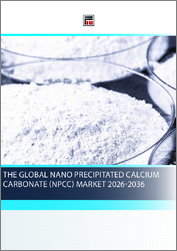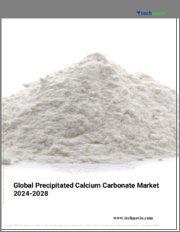
|
시장보고서
상품코드
1423751
침강탄산칼슘 시장 예측(-2030년) : 용도별, 지역별 세계 분석Precipitated Calcium Carbonate Market Forecasts to 2030 - Global Analysis By Application and by Geography |
||||||
Stratistics MRC에 따르면 세계의 침강탄산칼슘 시장은 2023년에 21억 1,000만 달러를 차지하고 예측 기간 중 CAGR 6.7%로 성장하며, 2030년에는 33억 3,000만 달러에 달할 것으로 예상되고 있습니다.
침강 탄산칼슘(PCC)은 다양한 산업 용도에서 광범위하게 사용되는 적응성 있는 화합물입니다. 탄산칼슘은 일반적으로 석회암 및 기타 광물에서 발견되는 칼슘이 풍부한 용액에서 침전시켜 생산되며, 고순도, 제어된 결정 구조 및 미세한 입자 크기와 같은 뛰어난 품질로 인해 다양한 산업 분야에서 유용하게 사용됩니다.
미국화학회에 따르면 침강 탄산칼슘(PCC)은 우수한 특성과 다양한 용도로 인해 제지, 고무, 플라스틱, 의약품 등 다양한 산업에서 중요한 역할을 하고 있습니다.
고분자 및 플라스틱에 대한 요구 증가
플라스틱 및 폴리머 분야에서 PCC는 기능성 충전재 및 보강재 역할을 하기 때문에 필수적입니다. PCC는 플라스틱 소재의 기계적 품질을 크게 향상시켜 건설, 자동차, 포장 등의 산업에서 높은 수요를 보이고 있습니다. 또한 PCC는 비용 효율성과 성능 향상 능력으로 인해 엄격한 품질 기준을 충족시키면서 생산 비용을 극대화하고자 하는 제조업체들이 선택하는 소재입니다.
원재료 가격 변동
상당량의 PCC는 석회석과 같은 원료를 사용하여 생산되며, 그 가격은 변동하기 쉽습니다. 이러한 원자재의 가용성과 가격은 경제 변동, 지정학적 동향 및 공급망 중단에 의해 영향을 받을 수 있으며, 이 모든 것이 PCC 생산의 총 비용에 직접적인 영향을 미칠 수 있습니다. 또한 안정적인 공급과 안정적인 가격을 보장하기 위해 이러한 변동을 관리하는 것은 생산자와 최종사용자에게 달려 있습니다.
제조 공정 기술 개발
PCC 제조의 생산성과 지속가능성을 향상시킬 수 있는 기회는 제조 기술 개발을 통해 얻을 수 있습니다. 전통적인 생산 공정과 관련된 에너지 사용 및 배출을 줄이기 위해 생산자는 탄소 회수 및 활용과 같은 첨단 기술에 투자할 수 있습니다. 또한 첨단 기술을 도입함으로써 기업의 경쟁력과 환경적 신용을 높일 수 있습니다.
대체 첨가제 및 충전제와의 경쟁
탈크, 카올린 및 기타 칼슘 기반 물질과 같은 대체 필러 및 첨가제는 다양한 용도에서 PCC와 경쟁하고 있습니다. 또한 경쟁력 있는 비용으로 동등한 품질을 제공할 수 있는 다양한 재료가 존재하는 상황에서 시장 점유율을 유지하기 위해 생산자는 지속적으로 혁신하고 PCC의 특별한 이점을 강조해야 합니다.
COVID-19의 영향 :
침강 탄산칼슘(PCC) 수요 및 공급은 COVID-19 팬데믹으로 인해 혼란을 겪으며 시장에 큰 영향을 미쳤습니다. 건축 프로젝트, 자동차 생산 및 기타 PCC에 크게 의존하는 주요 산업은 봉쇄 조치, 산업 활동 제한 및 세계 경제의 불확실성으로 인해 어려움을 겪었습니다. 공급망의 혼란, 물류의 어려움, 노동력 부족은 생산 능력을 더욱 압박했습니다.
예측 기간 중 제약 분야가 가장 큰 비중을 차지할 것으로 예상
침강 탄산칼슘(PCC) 시장에서 제약업계는 일반적으로 가장 큰 점유율을 차지하고 있으며, PCC는 순도가 높고 제약 기준에 부합하기 때문에 제약업계는 다양한 의약품의 부형제 및 칼슘 보충제로 널리 사용되고 있습니다. PCC는 활성 성분의 방출을 조절하는 결합제 및 보조제로서 정제의 경도를 높이고, PCC는 의약품에 적합하기 때문에 의료 산업에서 선호되고 있습니다. 또한 전 세계에서 건강 문제에 대한 인식이 높아짐에 따라 제약 용도에서 PCC에 대한 수요도 증가할 것으로 예상됩니다.
가장 높은 점유율을 차지하는 지역 :
유럽은 침강 탄산칼슘(PCC) 시장에서 가장 큰 점유율을 차지할 것으로 예상됩니다. 탄탄한 산업 기반, 엄격한 품질 관리, 제지 및 펄프, 플라스틱, 제약, 건설 등 다양한 산업 분야에서 PCC의 폭넓은 용도가 유럽 시장을 정의하고 있으며, 유럽연합(EU)의 지속가능성 및 환경 규제와 친환경 제조 방법 및 녹색 구상에 대한 관심으로 인해 PCC의 사용이 더욱 확대되고 있습니다. 친환경 제조 방식과 녹색 구상의 수많은 용도로 인해 PCC는 더욱 널리 사용되고 있습니다.
CAGR이 가장 높은 지역 :
침강 탄산칼슘(PCC) 시장은 아시아태평양에서 가장 높은 CAGR로 성장할 것으로 예상됩니다. 이는 이 지역의 급속한 산업화, 건축 활동 증가, 다양한 산업 분야 수요 증가로 설명할 수 있습니다. 제약, 자동차, 건설 등 PCC에 의존하는 산업은 모두 중국, 인도와 같은 국가에서 크게 성장하고 있습니다. 또한 이 지역의 도시화와 인구 증가는 제지, 코팅, 플라스틱 등의 산업에서 PCC의 필요성을 증가시키고 있습니다.
무료 맞춤형 서비스 :
이 보고서를 구독하는 고객은 다음과 같은 무료 맞춤화 옵션 중 하나를 사용할 수 있습니다. :
- 기업 개요
- 추가 시장 기업의 종합적인 프로파일링(최대 3사)
- 주요 기업의 SWOT 분석(최대 3사)
- 지역 세분화
- 고객의 관심에 따른 주요 국가별 시장 추정치, 예측, CAGR(주: 타당성 확인에 따라 다름)
- 경쟁사 벤치마킹
- 제품 포트폴리오, 지역적 입지, 전략적 제휴를 기반으로 한 주요 기업 벤치마킹
목차
제1장 주요 요약
제2장 서문
- 개요
- 이해관계자
- 조사 범위
- 조사 방법
- 데이터 마이닝
- 데이터 분석
- 데이터 검증
- 조사 어프로치
- 조사 소스
- 1차 조사 소스
- 2차 조사 소스
- 전제조건
제3장 시장 동향 분석
- 촉진요인
- 억제요인
- 기회
- 위협
- 애플리케이션 분석
- 신흥 시장
- 신종 코로나바이러스 감염증(COVID-19)의 영향
제4장 Porter's Five Forces 분석
- 공급 기업의 교섭력
- 구매자의 교섭력
- 대체품의 위협
- 신규 진출업체의 위협
- 경쟁 기업간 경쟁 관계
제5장 세계의 침강탄산칼슘 시장 : 용도별
- 염화비닐 파이프
- 개요와 케이블
- 고무
- 실란트 및 접착제
- 제지 산업
- 페인트 및 코팅 산업
- 인쇄 잉크
- 제약 산업
- 식품 업계
- 화장품 산업
- 기타 용도
제6장 세계의 침강탄산칼슘 시장 : 지역별
- 북미
- 미국
- 캐나다
- 멕시코
- 유럽
- 독일
- 영국
- 이탈리아
- 프랑스
- 스페인
- 기타 유럽
- 아시아태평양
- 일본
- 중국
- 인도
- 호주
- 뉴질랜드
- 한국
- 기타 아시아태평양
- 남미
- 아르헨티나
- 브라질
- 칠레
- 기타 남미
- 중동 및 아프리카
- 사우디아라비아
- 아랍에미리트
- 카타르
- 남아프리카공화국
- 기타 중동 및 아프리카
제7장 주요 발전
- 계약, 파트너십, 협업, 합병사업
- 인수합병
- 신제품의 발매
- 사업 확대
- 기타 주요 전략
제8장 기업 개요
- Minerals Technologies Inc
- Omya AG
- Imerys
- Maruo Calcium Co. Ltd
- J.M. Huber Corporation
- Schaefer Kalk GmbH & Co KG
- Huber Engineered Materials
- Galaxy Corporation
- Excalibar Minerals LLC
- Calchem Industries Ltd
According to Stratistics MRC, the Global Precipitated Calcium Carbonate Market is accounted for $2.11 billion in 2023 and is expected to reach $3.33 billion by 2030 growing at a CAGR of 6.7% during the forecast period. Precipitated calcium carbonate, or PCC, is a widely used and adaptable chemical compound with a wide range of industrial uses. Calcium carbonate is created by precipitating it from solutions that are rich in calcium, usually found in limestone or other mineral sources. PCC is useful in a variety of industries due to its exceptional qualities, which include high purity, controlled crystalline structure, and fine particle size.
According to the American Chemical Society, Precipitated Calcium Carbonate (PCC) plays a crucial role in various industries, including paper manufacturing, rubber, plastics, and pharmaceuticals, due to its exceptional properties and versatile applications.
Market Dynamics:
Driver:
Increased need for polymers and plastics
In the plastics and polymers sector, PCC is essential because it serves as a functional filler and reinforce. The mechanical qualities of plastic materials are greatly enhanced by PCC, which is in high demand in industries like construction, automotive, and packaging. Additionally, PCC is the material of choice for manufacturers who want to maximize production costs while meeting strict quality standards because of its cost-effectiveness and capacity to improve performance.
Restraint:
Raw material prices volatility
A significant amount of PCC is produced using raw materials like limestone, the price of which is subject to change. The availability and price of these raw materials can be affected by economic variables, geopolitical developments, and supply chain interruptions, all of which have a direct impact on the total cost of PCC production. Furthermore, it is up to producers and end users to manage this volatility in order to guarantee steady supply and stable prices.
Opportunity:
Technological developments in manufacturing procedures
Opportunities to improve the productivity and sustainability of PCC manufacturing are presented by ongoing developments in production technologies. To lower the energy use and emissions linked to conventional production processes, producers can invest in cutting-edge techniques like carbon capture and utilization. Moreover, a company's competitiveness and environmental credentials can be enhanced by embracing cutting-edge technologies.
Threat:
Competition from substitute additives and fillers
Alternative fillers and additives, like talc, kaolin, and other calcium-based substances, compete with PCC in a variety of applications. Additionally, to preserve its market share in the face of a wide range of materials that might provide comparable qualities at competitive costs, producers must constantly innovate and highlight the special advantages of PCC.
Covid-19 Impact:
Precipitated calcium carbonate (PCC) supply and demand were disrupted by the COVID-19 pandemic, which had a substantial effect on the market. Building projects, the production of automobiles, and other important industries that significantly rely on PCC were hindered by the lockdown measures, limitations on industrial activity, and uncertainties in the world economy. Further taxing production capabilities were disruptions in the supply chain, difficulties in logistics, and a labor shortage.
The Pharmaceutical segment is expected to be the largest during the forecast period
In the precipitated calcium carbonate (PCC) market, the pharmaceutical industry usually has the largest share. Because of PCC's high purity and compliance with pharmaceutical standards, the pharmaceutical industry uses it extensively as an excipients and calcium supplement in a variety of drug formulations. As a binder and helper in regulating the release of active ingredients, PCC adds to the hardness of tablets. Because of its qualities that make it suitable for pharmaceutical use, PCC is favored in the healthcare industry. Moreover, as awareness of global health issues increases, so too will the need for PCC in pharmaceutical applications.
Region with largest share:
In the market for precipitated calcium carbonate (PCC), the European region is projected to hold the largest share. A strong industrial foundation, strict quality controls, and a wide range of PCC applications in industries including paper and pulp, plastics, pharmaceuticals, and construction define the European market. PCC has become more widely used as a result of the European Union's emphasis on sustainability and environmental regulations, as well as its environmentally friendly production methods and numerous uses in green initiatives.
Region with highest CAGR:
The precipitated calcium carbonate (PCC) market is expected to grow at the highest CAGR in the Asia-Pacific region. This is explained by the area's quick industrialization, rising building activity, and rising demand from a variety of industries. The PCC-dependent industries of pharmaceuticals, automobiles, and construction are all expanding significantly in nations like China and India. Additionally, the region's growing urbanization and population are increasing the need for PCC in industries like paper, coatings, and plastics.
Key players in the market
Some of the key players in Precipitated Calcium Carbonate market include Minerals Technologies Inc, Omya AG, Imerys, Maruo Calcium Co. Ltd, J.M. Huber Corporation, Schaefer Kalk GmbH & Co KG, Huber Engineered Materials, Galaxy Corporation, Excalibar Minerals LLC and Calchem Industries Ltd.
Key Developments:
In July 2023, Minerals Technologies Inc. announced that it has entered into an agreement with a leading global paper company to upgrade one of the Company's existing precipitated calcium carbonate (PCC) plants in the Brazil by integrating MTI's NewYield® LO PCC technology. MTI's proprietary NewYield® technology converts a waste stream from a paper mill's pulping operation into a functional filler pigment.
In May 2023, Imerys, the world's leading supplier of mineral-based specialty solutions is collaborating with TotalEnergies to install a large-scale solar power system paired with battery energy storage at its Lompoc facility in Santa Barbara County, California, as part of a long-term energy services contract. This project is in alignment with Imerys' commitment to reducing greenhouse gas emissions across its global facilities and will eliminate approximately 7,000 metric tons of CO2 emissions annually.
In June 2022, Omya, a leading global producer of industrial minerals and a worldwide distributor of specialty ingredients, has reached an agreement to acquire agricultural prills assets of MK Minerals, a privately held American specialty fertilizers producer, headquartered in Wathena, KS, serving customers in many key markets including row and specialty crops, turfgrass and home retail industry.
Applications Covered:
- PVC Pipe
- Profiles & Cable
- Rubber
- Sealant & Adhesives
- Paper Industry
- Paint & Coating Industry
- Printing Ink
- Pharmaceutical Industry
- Food Industry
- Cosmetics Industry
- Other Applications
Regions Covered:
- North America
- US
- Canada
- Mexico
- Europe
- Germany
- UK
- Italy
- France
- Spain
- Rest of Europe
- Asia Pacific
- Japan
- China
- India
- Australia
- New Zealand
- South Korea
- Rest of Asia Pacific
- South America
- Argentina
- Brazil
- Chile
- Rest of South America
- Middle East & Africa
- Saudi Arabia
- UAE
- Qatar
- South Africa
- Rest of Middle East & Africa
What our report offers:
- Market share assessments for the regional and country-level segments
- Strategic recommendations for the new entrants
- Covers Market data for the years 2021, 2022, 2023, 2026, and 2030
- Market Trends (Drivers, Constraints, Opportunities, Threats, Challenges, Investment Opportunities, and recommendations)
- Strategic recommendations in key business segments based on the market estimations
- Competitive landscaping mapping the key common trends
- Company profiling with detailed strategies, financials, and recent developments
- Supply chain trends mapping the latest technological advancements
Free Customization Offerings:
All the customers of this report will be entitled to receive one of the following free customization options:
- Company Profiling
- Comprehensive profiling of additional market players (up to 3)
- SWOT Analysis of key players (up to 3)
- Regional Segmentation
- Market estimations, Forecasts and CAGR of any prominent country as per the client's interest (Note: Depends on feasibility check)
- Competitive Benchmarking
- Benchmarking of key players based on product portfolio, geographical presence, and strategic alliances
Table of Contents
1 Executive Summary
2 Preface
- 2.1 Abstract
- 2.2 Stake Holders
- 2.3 Research Scope
- 2.4 Research Methodology
- 2.4.1 Data Mining
- 2.4.2 Data Analysis
- 2.4.3 Data Validation
- 2.4.4 Research Approach
- 2.5 Research Sources
- 2.5.1 Primary Research Sources
- 2.5.2 Secondary Research Sources
- 2.5.3 Assumptions
3 Market Trend Analysis
- 3.1 Introduction
- 3.2 Drivers
- 3.3 Restraints
- 3.4 Opportunities
- 3.5 Threats
- 3.6 Application Analysis
- 3.7 Emerging Markets
- 3.8 Impact of Covid-19
4 Porters Five Force Analysis
- 4.1 Bargaining power of suppliers
- 4.2 Bargaining power of buyers
- 4.3 Threat of substitutes
- 4.4 Threat of new entrants
- 4.5 Competitive rivalry
5 Global Precipitated Calcium Carbonate Market, By Application
- 5.1 Introduction
- 5.2 PVC Pipe
- 5.3 Profiles & Cable
- 5.4 Rubber
- 5.5 Sealant & Adhesives
- 5.6 Paper Industry
- 5.7 Paint & Coating Industry
- 5.8 Printing Ink
- 5.9 Pharmaceutical Industry
- 5.10 Food Industry
- 5.11 Cosmetics Industry
- 5.12 Other Applications
6 Global Precipitated Calcium Carbonate Market, By Geography
- 6.1 Introduction
- 6.2 North America
- 6.2.1 US
- 6.2.2 Canada
- 6.2.3 Mexico
- 6.3 Europe
- 6.3.1 Germany
- 6.3.2 UK
- 6.3.3 Italy
- 6.3.4 France
- 6.3.5 Spain
- 6.3.6 Rest of Europe
- 6.4 Asia Pacific
- 6.4.1 Japan
- 6.4.2 China
- 6.4.3 India
- 6.4.4 Australia
- 6.4.5 New Zealand
- 6.4.6 South Korea
- 6.4.7 Rest of Asia Pacific
- 6.5 South America
- 6.5.1 Argentina
- 6.5.2 Brazil
- 6.5.3 Chile
- 6.5.4 Rest of South America
- 6.6 Middle East & Africa
- 6.6.1 Saudi Arabia
- 6.6.2 UAE
- 6.6.3 Qatar
- 6.6.4 South Africa
- 6.6.5 Rest of Middle East & Africa
7 Key Developments
- 7.1 Agreements, Partnerships, Collaborations and Joint Ventures
- 7.2 Acquisitions & Mergers
- 7.3 New Product Launch
- 7.4 Expansions
- 7.5 Other Key Strategies
8 Company Profiling
- 8.1 Minerals Technologies Inc
- 8.2 Omya AG
- 8.3 Imerys
- 8.4 Maruo Calcium Co. Ltd
- 8.5 J.M. Huber Corporation
- 8.6 Schaefer Kalk GmbH & Co KG
- 8.7 Huber Engineered Materials
- 8.8 Galaxy Corporation
- 8.9 Excalibar Minerals LLC
- 8.10 Calchem Industries Ltd



















